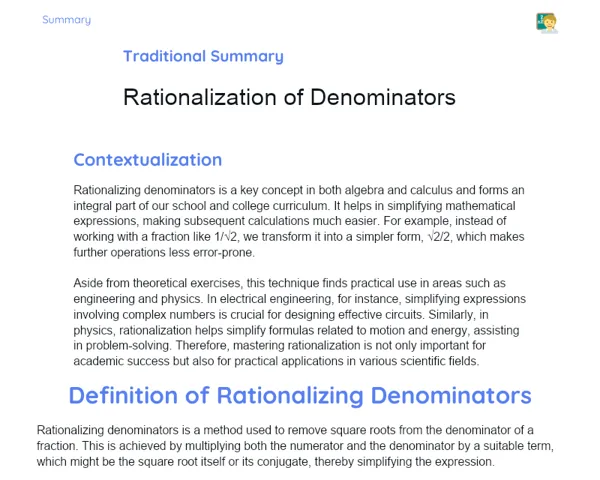Socioemotional Summary Conclusion
Goals
1. Identify and understand the differences between prime and composite numbers.
2. Break down numbers into their prime factors, using practical examples like 12 = 2² x 3.
Contextualization
Did you know that prime numbers are like the superheroes in the world of mathematics? 💪🔢 They play a vital role in keeping our information secure online through encryption, ensuring that our passwords and personal data remain protected. Understanding prime and composite numbers is not just about solving math problems; it reveals how mathematics is intertwined with the technology we rely on every day! 🌐✨
Exercising Your Knowledge
Prime Numbers
Prime numbers are the essential 'building blocks' of mathematics. They are natural numbers greater than 1 that can only be divided by 1 and themselves, leaving no remainder. This concept is fundamental, as all composite numbers are formed by multiplying prime numbers. Thus, grasping the concept of prime numbers is like understanding the atoms of mathematics.
-
Definition: Natural numbers greater than 1 that have exactly two divisors: 1 and themselves.
-
Examples: 2, 3, 5, 7, 11, 13, 17, 19.
-
Importance: They serve as the foundation for breaking down composite numbers and are crucial in fields like cryptography.
Composite Numbers
Composite numbers are those that have more than two divisors. This means they can be divided by 1, themselves, and at least one other natural number. Breaking down a composite number into prime factors is a vital technique in mathematics, aiding the resolution of various problems.
-
Definition: Natural numbers greater than 1 that possess more than two divisors.
-
Examples: 4, 6, 8, 9, 10, 12, 14, 15.
-
Importance: A solid understanding of composite numbers enables the skill of decomposition into prime factors, which is essential for tackling more advanced mathematical challenges.
Decomposition into Prime Factors
Decomposition into prime factors involves expressing a composite number as the product of prime numbers. For instance, 12 can be expressed as 2² x 3. This technique is crucial for simplifying calculations and resolving more intricate mathematical problems.
-
Definition: The method of breaking down a composite number into its prime factorization.
-
Example: 12 = 2² x 3.
-
Importance: This process simplifies calculations and is a core skill for solving various mathematical problems.
Key Terms
-
Prime Numbers: Natural numbers greater than 1 that can only be divided by 1 and themselves.
-
Composite Numbers: Natural numbers greater than 1 that can be divided by additional numbers apart from 1 and themselves.
-
Decomposition into Prime Factors: The technique of expressing a composite number as a product of its prime factors.
-
Sieve of Eratosthenes: An ancient and effective method for identifying all prime numbers below a specified number, discarding multiples of each prime.
For Reflection
-
How did you feel while working in a group to solve the problems? Did you find it challenging to collaborate and reach solutions together?
-
In what day-to-day situations do you notice the use of prime and composite numbers? How can this understanding assist you beyond the classroom?
-
While breaking down numbers into prime factors, did you observe any patterns or strategies that made the task easier? How did this insight impact your confidence in addressing math problems?
Important Conclusions
-
Prime numbers are the core building blocks of mathematics. They are natural numbers greater than 1 that can only be divided by 1 and themselves.
-
Composite numbers are natural numbers greater than 1 that have more than two divisors. They can be decomposed into prime factors, which is crucial for solving complex mathematical challenges.
-
Decomposing into prime factors is a mathematical technique allowing the expression of a composite number as a product of prime numbers, such as expressing 12 as 2² x 3.
-
The Sieve of Eratosthenes is a historical and efficient technique for identifying all prime numbers less than a specified number, removing multiples of each prime number.
Impacts on Society
The significance of prime numbers in today’s world is extensive, particularly in digital security. For instance, prime numbers are utilized to create cryptographic keys that safeguard our sensitive information online, like passwords and banking details. Therefore, every time you perform a secure online transaction, you're benefiting from the principles of prime numbers we explore in class. Moreover, understanding prime and composite numbers fosters logical reasoning and problem-solving abilities, vital for numerous careers from engineering to computer science. Developing these skills not only expands your professional opportunities but also enhances your capacity to make informed decisions in everyday life, encouraging a more analytical approach to addressing complex problems.
Dealing with Emotions
As you study prime and composite numbers, take a moment to 'Recognize' your feelings about the challenge. Ask yourself: 'Am I feeling anxious, frustrated, or confident?' Then, try to 'Understand' the reasons behind those emotions. It might stem from the topic being unfamiliar or from the desire to excel. 'Name' that emotion accurately - it could be 'nervousness' or 'excitement'. Following that, 'Express' your feelings constructively, whether by chatting with a peer or jotting them down. Finally, 'Regulate' any emotions through calming techniques like deep breathing or purposeful breaks during your studies to help maintain focus.
Study Tips
-
Create flashcards featuring examples of prime and composite numbers, and practice breaking these down into their prime factors regularly.
-
Engage in math games and educational apps that focus on prime numbers to make studying more interactive and enjoyable.
-
Form study groups with your classmates to discuss and address problems collaboratively, harnessing teamwork to enhance your understanding of the subject.



